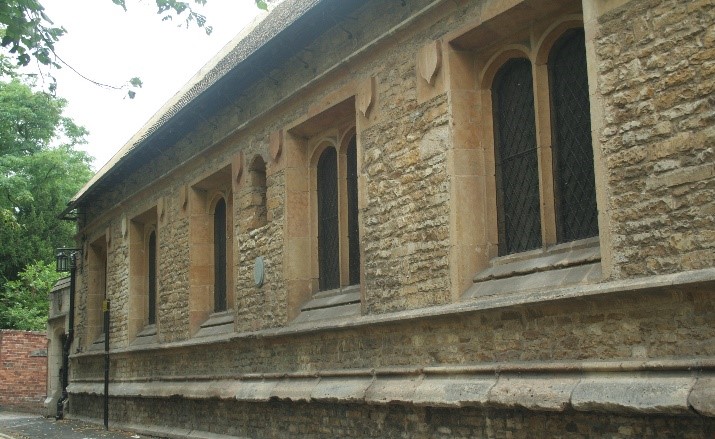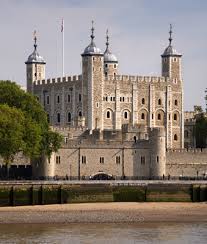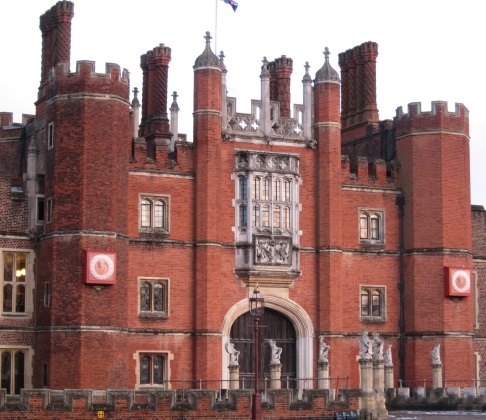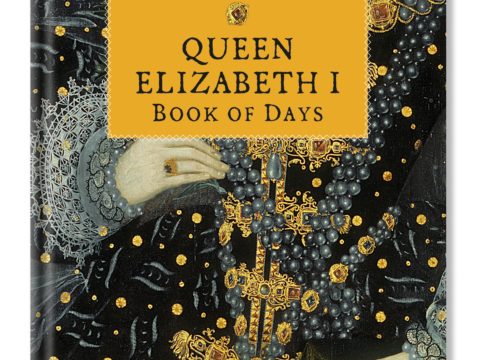William Cecil: Bourne to Burghley
Cecil was a Lincolnshire man, born and bred, and he always saw that county as his own. But as a politician, he needed to keep close to the centre of power and he spent the majority of his life in and around the capital, building several houses to reflect his status.
The numbers against the places correspond to those on the map here and at the end of this article.
When William Cecil was born in 1520 in the small town of Bourne (1) in Lincolnshire, it was to a family that, on his mother’s side, was well-established in the district, with a history of service in the various civic offices of Bourne and membership of the religious guilds of the town. His father’s family had settled in the neighbouring town of Stamford only in the last quarter of the fifteenth century, having come from South Wales, probably because of their connection, through the god-father of William’s father Robert, with Lady Margaret Beaufort. Lady Margaret had an impressive estate nearby at Collyweston, and the Cecils had roles in its management. Thirty years later, William was to be steward of some of those lands on behalf of Lady Margaret’s grand-daughter, Elizabeth.
William was christened in the Abbey Church of St Peter and St Paul, which, generally referred to as Bourne Abbey still stands in the town, although the monastic buildings are long gone. At the time, the Abbey was an Augustinian foundation, at the heart of town life and Cecil’s maternal grandparents are buried there.
Around 15 miles from Bourne is the large town of Grantham. Situated just off the A1, or in more romantic parlance, the Great North Road, it has been a settlement probably since Neolithic times. It was certainly in existence at the time of the Domesday Book in 1086. In the older part of the town is the enormous church of St Wulfram, noted in Simon Jenkins’ ‘1000 Best Churches in England’, as having the best steeple (282 ft in height) in the country.In the shadow of this enormous edifice is the old schoolhouse (2) that Cecil would have known when he came to be educated there. Cecil probably arrived not long after the school had been re-founded by Dr Richard Foxe, Bishop of Winchester, and once Lord Privy Seal.

Perhaps because of his youth, Cecil did not remain so far from home for long. Instead, he was moved to a school rather closer at Stamford (3). Stamford, like Grantham, is a settlement on the Great North Road. It is one of the loveliest towns in the whole of England, built of the local oolitic limestone, a hard-wearing, creamy stone. The town is home to an extraordinary number of mediaeval churches, as well as one of the oldest inns in the country. The Tabard at Stamford was a thriving business, and the family of Cecil’s grandmother, Alice Dicons, had some interest in it, although, contrary to rumours intended to denigrate Cecil in later life, they were not the innkeepers.
The Tabard has been renamed the George, and is well worth a visit. Stamford school still exists too, although the buildings, which are dotted around the town, almost all post-date Cecil.
At the age of 14, the usual age, Cecil went to the College of St John the Evangelist, Cambridge (4). This College had been founded in the Will of Lady Margaret Beaufort, and so had associations for Cecil’s family. During this period, he met and built relationships with some of the men who would influence him in religious matters and be politically associated with him throughout his career – John Cheke, Roger Ascham, Thomas Smith and Edmund Grindal were all either studying or teaching there. His friendship with John Cheke led on to affairs of the heart. To the intense disapproval of his father, he married Cheke’s sister, Mary, although she died young, leaving Cecil with a baby son.
St John’s College is still a functioning college of the university, and, in fact, is one of the largest. It can be visited between March and October between 10am and 5pm and during the winter between 10am and 3.30pm. A good proportion of the buildings are those that Cecil would have known – particularly the Great Gatehouse, completed in 1519 and sporting the arms of Lady Margaret – the Beaufort Portcullis supported by her heraldic beast, the Yale. The chapel is a gothic confection by Gilbert Scott, dating from the nineteenth century.
After his five years at St John’s, Cecil went to study law at Gray’s Inn (5).Again, the place itself is still an Inn of Court, but the buildings have been much altered. There are remnants that Cecil would have known as a student, in the Chapel and the Hall, although both have been extensively rebuilt since his time, the Hall as early as the 1550s, so it would look familiar to him.
In the early 1540s, with his marriage to Mildred, one of the daughters of the courtier, Sir Anthony Cooke, Cecil began to spend time in and around the King’s court. It was not, however, until he was working for the Duke of Somerset, early in the reign of Edward VI that we have exact information on where he lived. At that time, he bought two houses in Canon Row, Westminster (6) from Lord Paget, for around £400 cash. This was not an insignificant amount of money, but there is no information as to how he raised the sum.
Cecil took his first trip out of the country in September 1549, when he travelled with the English army to Scotland. He was present at the Battle of Pinkie Cleugh, and afterwards, when the English marched on Edinburgh (7).
Returning from Scotland, Cecil continued to live at Canon Row, when in London, for at least ten years, but an aspiring courtier also needed a country home. In 1549, he became interested in property in Wimbledon, and discussed with Sir Robert Tyrwhitt, the possibility of acquiring the remainder of a sixty year lease of the Rectory of Wimbledon (8).
The lands in and around Wimbledon had been owned by the Abbey of Worcester, and, at the Dissolution of the Monasteries had transferred to the Crown. There were two parts to the estate – the Manor of Wimbledon, which included a manor house and was near modern Mortlake, and the Rectory, which included a Parsonage near the Church of St Mary’s, Wimbledon.
The Rector had the right of presentation of rectors to the Church of St Mary’s and curates to Mortlake and Putney. He also had the right to collect the tithes and either farm the glebe (church lands) himself, or lease it out. In return, the Rector had to maintain the three churches mentioned.
The Manor of Wimbledon had been granted to Thomas Cromwell, and then to Queen Katherine Parr. The Rectory had been returned to the Dean and Chapter of the new Cathedral at Worcester, who had leased it out, and it was the remainder of this lease that Cecil now acquired. He also acquired more land, north of what is now Worple Road in Wimbledon, stretching up towards the Common. He was fined 6d in 1555 for not maintaining his gate there properly.
During Edward’s reign, Cecil spent the majority of his time at Canon Row, during Mary’s sovereignty he spent more time at Wimbledon. It was in either of these places that the first four children of his marriage to Mildred were born – Frances, Anne, and two babies, both named William. Only Anne, born in Westminster, survived and the others are buried in St Mary’s Church.
Living at Wimbledon with him were his wife, Mildred; his sister, Margaret, later Mrs Cave; Mildred’s sister, Elizabeth, later Lady Hoby; his son, Thomas, and his two wards at the time, Arthur Hill and John Stanhope. When the Manor of Wimbledon was granted by Mary to Cardinal Pole, William became his steward for the land.
In late 1549, Cecil exchanged his comfortable quarters at Canon Row, for a stint in the Tower of London. As a gentleman prisoner of means, he would not have been kept in a dank cell, but in one of the better rooms. He would have had to pay for his own keep. His sojourn there was short, only about 5 weeks, but we can suppose he was glad to leave.

A far more enjoyable moment in a royal palace would have been on 5 th September 1550, at Oatlands Palace (10) when he was given a place on the Privy Council as Secretary. Oatlands Palace, which was near the village of the same name in Surrey, has completely disappeared now – it was demolished under the Commonwealth in the 1650s. A single building on the estate, some distance from the palace, was developed into Oatlands House and parts of it are in the hotel currently on the site.

Another high point would have been at Hampton Court Palace (11) on 11th October 1551, when he was knighted.

It was at Ingatestone Hall (12), in Essex, the home of his fellow Secretary, Sir William Petre, that Cecil came to swear allegiance to Mary, after the failure of the attempt to replace her with Lady Jane Grey. Although the Queen pardoned him she did not immediately take him back into government service.
In the years when Cecil was not directly in government employ, he travelled around London and the nearby counties, visiting friends, such as the Hobys at Bisham, and his parents still in Stamford, on their property at Burghley, just south of the town. Cecil was a compulsive recorder of detail, and information exists about one of his trips to Burghley during this period, which he undertook in company with his servant, Thomas Cayworth.
The two left Wimbledon on the morning of Sunday, 2nd May, with four horses. Cecil crossed the river by the Wandsworth ferry, which delivered him close to Canon Row, whilst Cayforth had to detour up to Lambeth to take the animals across the Thames on the horse-ferry (hence the name Horseferry Road in South London today.) They slept at Canon Row that night, then, on the following day had dinner at Ware in Hertfordshire – probably about 11am, having covered 25 miles, followed by supper at Royston, a further 20 miles. We can infer from this that they followed the route of the modern A10. The next day they completed the full 50 miles on to Stamford, probably crossing westward to the Great North Road at Huntingdon.
Cecil remained in Stamford until 13th May, on which date he and Cayworth arrived in Huntingdon in time for dinner, and supped and slept at Royston.Dinner at Ware on 14th was followed by a long ride back into London, and a ferry crossing at Westminster, arriving at Stangate on the south side. From there, they probably followed what is now the A3 to arrive back in Wimbledon for bed. The whole journey cost 14s 5d on the outward trip, and 12s 5d to return.
There were two trips abroad during Mary’s reign, the first, to Brussels to escort Cardinal Pole home, and the second, also to Brussels on government business, but followed up by independent travel to Antwerp and other places. During Mary’s reign, Cecil also began his refurbishment of Burghley House at Stamford (3), which he inherited in 1553.
We know that Cecil was at Hatfield in November 1558, when Elizabeth received the news of her half-sister’s death. From that time he was in constant attendance on the Queen at the various royal palaces, Whitehall, Nonsuch, Richmond, Oatlands and others. In 1572 he was installed as the 356th Knight of the Order of the Garter, at St George’s Chapel, Windsor Castle (13).
For domestic purposes, Cecil and his family had outgrown Wimbledon, which was passed to his son, Thomas. Instead, Cecil developed a grand new property in the Strand. Cecil House (14) was situated more or less opposite where the Savoy Theatre is today. He lavished time and money on it, and it was here that he died in 1598.
But even Cecil House and Burghley House did not satisfy Cecil’s architectural passions. He created the most beautiful of all of the Elizabeth Prodigy houses at Theobalds (15), near Cheshunt, on the northern fringes of London. Nothing remains of it today – another palace pulled down during the Commonwealth.
For all Cecil’s ties to London, when he died, he chose to go home to Stamford. Following his death on 4th August, 1598, at Cecil House, he began his last journey. He was transported to Westminster Abbey where over five hundred people attended his funeral. Then, following his orders, his cortege which consisted of only twelve men, accompanied the black draped coach containing the coffin the 100 miles to Stamford. At each resting place the poor of the parish were to be given 40s. He was entombed next to the memorial he had built for his parents in the church of St Martin Without, a thirteenth century church on the west of Stamford, about a mile from Burghley. There he rests, alone in his sumptuous monument, awaiting the resurrection and that final passage he so firmly believed in.
The map below shows the location of the places associated with William Cecil discussed in this article.



